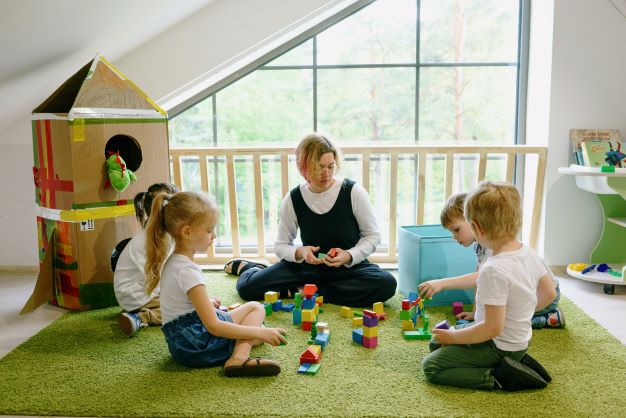A key aspect to understand in social and emotional learning is the importance of managing emotions. Incorporating ways to manage emotions in a classroom setting can help teach children skills necessary to live rewarding lives. If children can get an education that teaches them how to deal with emotions in a healthy way, they are more likely to thrive.
Managing emotions in a positive way has far-reaching benefits. Not only will a kid with the ability to self-regulate their feelings experience better social interactions, but there are also health benefits to effective emotional management. People who know how to manage their emotions in a positive way will have better cardiovascular health. (HHP) Good emotional health quite literally gives people good hearts.
While there are many techniques that might prove effective for positive emotional management, we have a favorite. The Empty Balloon is an exercise we often implement here at Soul Shoppe.
The Empty Balloon Exercise — How it Works
The Empty Balloon Exercise is an emotional management tool. It begins by having students visualize emotional states as big balloons. As the emotion expands, the imagined balloon expands. And what happens to balloons when they overinflate?
They pop.
In an effort to avoid emotional explosions, the idea is to find ways to release pressure from your emotional ballon before they pop.
The Empty Balloon Exercise serves as a teaching metaphor to describe the psychology and physiology behind effective emotional management. Click here to learn more about the Emotional Balloon Exercise.
Improving Emotional Intelligence for Elementary Students
Emotional intelligence is a critical factor in the effective management of emotions. The practice of improving emotional intelligence is a lifelong challenge for most of us. It’s valuable to prepare children with a solid foundation in understanding how to interpret and manage emotions. This includes their own and those of other people.
In order to improve emotional intelligence, teachers and parents can incorporate certain activities into their curricula. Such as: (DCE)
- Self-awareness activities. Activities like journaling and role-playing help children learn self-awareness. Reading is also a good tool for learning self-awareness.
- Practicing self-regulation. Exercises like pausing to breathe before reacting and recognizing your own emotions are important. Board games and active games like Simon Says help kids learn and practice self-regulation skills.
- Empathy is an important part of improving emotional management. It may not come naturally for children to think about how other kids feel. Activities like check-ins including the whole class, or role-playing help students practice empathy.
- Cultivating social skills. Nothing teaches emotional intelligence better than social interaction. Providing children with opportunities to practice social skills gives them practical experience in developing emotional awareness. Team sports and playing games as teams provide good aids in teaching social skills.
A lot goes into emotional intelligence. With a strong grounding in emotional awareness, students can learn lessons to help them manage and control their emotions in healthy ways. (HBS)
Sometimes children find it challenging to differentiate between feelings and emotions. It is important to develop the skills to identify when it is an emotion and when it is a feeling. Feelings are generally immediate reactions to situations, while emotions often involve a deeper psychological reality. (iMotions)
How to Manage and Control Emotions in Healthy Ways

Emotional balloons will inflate. Being human means having emotions. Developing emotional intelligence is a lifelong skill. When kids can identify what they’re feeling, they will have better luck deflating their emotional balloons.
There are a handful of good ways to deflate your emotional balloon. Here are a few: (SoulShoppe)
- Hang out with friends. Social interaction helps raise emotional awareness and helps turn negative emotions into positive ones.
- Dance it out. Engaging the body with an activity unrelated to a negative emotion helps reduce the pressure in your emotional balloon. Plus…
- Listening to music is always a good emotional outlet!
- Stop and breathe for a second before doing the next thing.
- Read a book. If the problem is getting too deep into your own head, books are great ways to change how you’re thinking.
- Give someone a hug. As naturally social animals, humans heal from positive physical contact.
- Find a chuckle. Laughing stimulates endorphin production and helps with mood regulation.
- Do something creative. Drawing a picture, singing a song, and writing some poetry, are all ways to redirect emotional energy in a positive way.
- Talking to someone trustworthy will also help relieve emotional stress a lot of the time.
- Cry if you need to!
There are a lot of ways to relieve pressure from your emotional balloon, or even empty it completely.
Peace Corner
Where can students go during the school day when they need a moment to empty their emotional balloons? A peace corner is a safe space that can be created in the classroom or at home where children can empty their emotional balloons. Find out how to create a peace corner here.
There are many opportunities for children to learn how to manage emotions in a positive way, at home and at school. Through creating and sharing social and emotional learning techniques, Soul Shoppe helps teachers and parents at home or in the classroom. Our SEL curriculum for elementary school students help children learn positive emotional management. We have developed tools like the Empty Emotional Balloon exercise and the Peace Corner to bring SEL tools to your curriculum. To learn about online SEL programs for elementary schools, click here. For home school social emotional programs, click here.


